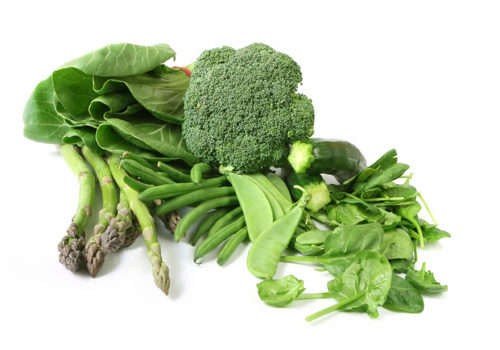![]()
Savvy shoppers are always looking to get the most “bang for their buck,” even when it comes to their dietary supplements. Green foods, with their wide variety of benefits ranging from fighting bad breath to acting as anticarcinogens, are some of nature’s best multitaskers.
What are Green Foods?
Green foods are extremely nutrient-dense plants and algae that can be processed into tablets or powders, mixed into a liquid and drunk like a smoothie. The most popular green foods are cereal grasses, alfalfa, green algae (chlorella), blue-green algae (spirulina) and dark green vegetables (such as spinach and parsley) (1).
How nutrient-dense are we talking? For reference, barley juice powder has 13 times as much carotene as carrots and five times more iron than spinach (2)! Green foods also contain high levels of chlorophyll, phytonutrients, amino acids, vitamin B, iron, calcium, carbohydrates and protein (3, 4). With such a potent nutrient cocktail, green foods “give the body what it needs to correct its own dysfunctions” (1).
Chlorophyll: Green Blood
Chlorophyll is the green pigment in plants and enables plants to convert sunlight into energy. Known as the “blood of plants,” chlorophyll’s composition and structure is very similar to that of human blood, and consumption of chlorophyll can lead to an increase in hemoglobin levels, benefiting patients with anemia (2).
Though it cannot be touted as a cure for cancer, research suggests chlorophyll acts as an anticarcinogen by forming tight complexes with cancer-causing chemicals, like those found in tobacco smoke. By binding in the digestive track, chlorophyll prevents some carcinogens from reaching susceptible tissues (2). Researchers studied chlorophyll’s effect on colon cancer risk in rats. Rats were fed either haem, which is found in red meat and known to cause pre-cancer lesions in the colon, or a combination of haem and spinach, which is high in chlorophyll. The excrement of rats fed spinach had three times as much haem as that of rats not fed spinach. The researchers concluded that the chlorophyll in the spinach prevented digestion of the detrimental haem (5).
Chlorophyll can be bought as a supplement in liquid form or soft gels, but it is also abundant in the green food supplements made from cereal grasses and algae.
Cereal Grasses and Diabetes
Cereal grasses are the young shoots of grain-bearing plants like wheat, barley, oats and rye. They can be processed into juices that contain high concentrations of phytonutrients, vitamins, chlorophyll and amino acids (4). In addition to many other benefits, studies have shown cereal grass to be useful to diabetics. In a study from Fu Jen University, 36 type-2 diabetics were given either barley grass supplements, vitamins A and E or a combination of all three for four weeks. Results showed that taking barley grass supplements may reduce cholesterol and oxygen free radicals in the blood of type-2 diabetics, as well as protect against the oxidation of LDL cholesterol (6).
Another study tested the glycemic index (GI) of foods made from cereal grass powders. Researchers found them to have low GIs and to lower the glycemic response in diabetics, making cereal grasses safe and beneficial for diabetics (7).
Not suffering from diabetes? Cereal grasses provide other benefits, including: detoxification of the body, aiding in protein synthesis, supporting the immune system and possibly reducing the activity of ulcerative colitis (8, 4).
Spirulina versus Allergies
Spirulina is a microscopic blue-green algae found in freshwater ponds, lakes and rivers. It is considered the “most nutritionally complete of all the food supplements,” containing high levels of protein (50–70% of its dry weight), complex carbohydrates, iron, vitamins K and B and carotenoids (3, 9). Spirulina lacks cell walls, allowing it to be easily digested and its nutrients to be easily absorbed. Its possible positive health effects are numerous and include antioxidant and antiviral properties; spirulina also has been effective against diabetes, obesity and anemia (3).
Does pollen make you sneeze? Studies have shown spirulina to be effective against allergic rhinitis (allergies). In a 12-week, double-blind study, participants who suffered from allergies were given either spirulina or a placebo. Their level of interleukin-4, a cytokine that is key in the development of allergic inflammation, was measured before and after the supplement was given. Results showed a 32% decrease in interleukin-4 levels in participants given high doses of spirulina, suggesting its protective effect toward allergies. Other studies found spirulina to increase mucosal immunity and provide relief from symptoms such as sneezing and nasal congestion (10).
Chlorella, A Super-Algae
Like spirulina, chlorella is also a fresh water algae that contains high levels of protein and chlorophyll. Multiple studies show it to be effective against infection, toxins, carcinogens and high cholesterol (11).
Due to its high levels of folate, vitamin D and iron, chlorella may be effective against hypertension and anemia. In a recent study, 70 pregnant women were given either six grams of chlorella or a placebo daily. The proportion of anemic women in the chlorella group was significantly lower than that of the placebo group. In addition, signs of pregnancy-induced hypertension were lower in the chlorella group. Other clinical trials reported an increased antibody response and decreased sitting diastolic blood pressure in participants who took a chlorella supplement (12). WF
References
1. M. Timon, “Green Foods Defined & Why We Eat Them,” http://www.vibranthealth.us/nutrition-education/article-library/green-foods/green-foods-defined-why-we-eat-them, accessed August 27, 2013.
2. S.R. Bhat, “Chlorophyll: The Wonder Pigment,” Science Reporter, 42 (7), 29-32 (2005).
3. T.G. Sotiroudis, “Health Aspects of Spirulina (Arthropspira) Microalga Foods Supplement,” Journal of the Serbian Chemical Society, 78 (3), 395-405 (2013).
4. R. Tiwari, G. Tiwari, A K. Rai, “Probiotic Novel Beverages and Their Applications,” Syst. Rev. Pharm., 2 (1), 30-36 (2011).
5. J. de Vogel, “Green Vegetables, Red Meat and Colon Cancer: Chlorophyll Prevents the Cytotoxic and Hyperproliferative Effects of Haem in Rat Colon,” Carcinogenesis, 26 (2), 387-393 (2004).
6. B. Terry, “Barley Grass Supports Cardiovascular Function,” http://www.greenfoods.com/store/pg/8-Research.aspx, accessed August 27, 2013.
7. S. Rohtagi, “Preliminary Phytochemical, Nutritional Potential of Cereal Grass Powder Based Products for Effective Management of Diabetes,” International Journal of Advances in Pharmacy, Biology and Chemistry, 2 (1), 234-240 (2013).
8. Herb Wisdom, “Wheatgrass,” www.herbwisdom.com/herb-wheatgrass.html, accessed August 26, 2013.
9. Herb Wisdom, “Spirulina,” www.herbwisdom.com/herb-spirula.html, accessed August 26, 2013.
10. P. D. Karkos et al., “Spirulina in Clinical Practice: Evidence-Based Human Applications,” Evidence-Based Complementary and Alternative Medicine, 2011 (2011), (2008).
11. Herb Wisdom, “Chlorella,” www.herbwisdom.com/herb-chlorella.html, accessed August 26, 2013.
12. G. Tang, “Vitamin A, Nutrition, and Health Values of Algae: Spirulina, Chlorella, and Dunaliella,” Journal and Pharmacy and Nutrition Sciences, (1), 111-113 (2011).
Published in WholeFoods Magazine, December 2013










